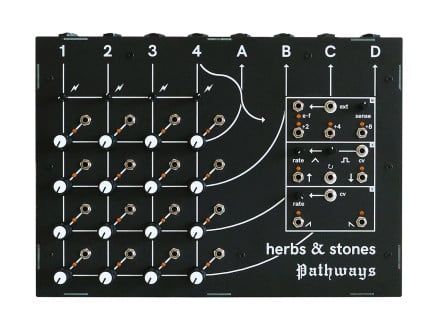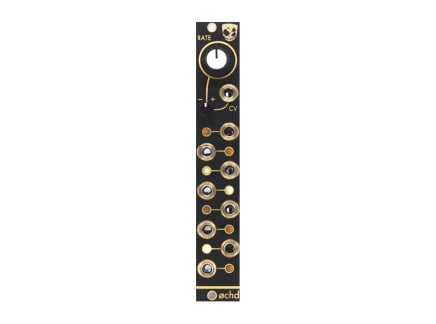The journey is always more rewarding than the destination itself, and one of the great delights in exploration is finding your own unique path. Meandering through the forest and finding hidden secrets you might not have noticed or areas that are still undiscovered, this is the joy of traveling. Not limited to the physical word, your creative process is also an adventure of self-discovery and the tools that we use can help us forge new pathways.
Pathways is a matrix mixer from Herbs & Stones with a few extra surprises, such as an envelope follower and two LFOs. If you're not familiar with a matrix mixer, it is a unique way to route multiple inputs to multiple outputs that can yield a ton of control over the signal path without having to re-patch cables. In the case of Pathways, you have four inputs and four outputs designated with a 4x4 grid. Each input has a set of individual level controls that adjust how much of that input goes to one of the outputs. This is what a matrix mixer is in its simplest form—however, Herbs & Stones is not satisfied with the status quo and adds some extra sauce for good measure.
In our video, the Pathways is used to redirect the flow of audio to a few different effects with modulation that was provided by both the internal sources and some external modules. Many of the patch points were connected to either gates, LFOs, or envelopes in order to create something that is rhythmic, sporadic, chaotic—and it all can be attenuated to the appropriate level. There are tons of options and directions to take the Pathways, so let's take a more detailed look at how it can be used.
Organic Movement and Automated Flow
Each of the level controls—16 in total—has a control voltage input which lets you patch in CV from your Eurorack system or any other source. Already, you can feel the wild possibilities—not the least of which is sequenced level controls which could function as a sort of VCA. But if you have each of the outputs connected to a different effect, perhaps also sequenced or synced with a common clock, the rhythmic nonsense can properly ensue. Of course, you can have something much more fluid with a few phased modulation sources from a Batumi, Pam's Pro Workout or øchd that patches into a few of these sources calling in a gentle reverb or delay, only to have it disappear again.
You might've noticed there's also a full right side of the device that has patch points as well. These are (mostly) outputs that you can use to patch into anything that will accept them, including back into the Pathways. Even if you don't have a modular system or only have a few small pieces of equipment, the Pathways is still a versatile fun device to use because of the inclusion of these utilities. From the top–down, we have an envelope follower and then 2 LFO sections. The envelope follower is normalized to the fourth input, so whatever source you have plugged in there will generate CV, but there's also a clock extractor/divider which outputs divisions of the clock at /2, /4, and /8. With the sensitivity knob, you can fine tune the amount of information that gets translated to the envelope follower's output and an external clock input can let you sync to outside sources.
Both LFO sections are great for modulation and differ slightly through their waveform offerings. The first LFO, X, is a variable shape LFO that moves from Triangle to Square and has two similar outputs: they are the same waveform but 180 degrees out of sync, or inverse of each other, making this LFO section perfect for ping-pong panning effects, or movement that should be related and opposite. Since there is also a square output, this means at faster settings you can create interesting rhythmic patterns with the on and off-beat. Since the waveshape is variable, in the midst of a performance you can quickly change the mood and mode of your set. The second LFO section, Y, is a pair of ramp-shaped waveforms with a rate control. While the waveforms are fixed, you can manually and via CV adjust the rate which can allow for some interesting self-patching movement. Our first LFO also has CV control over the rate but includes a unique Reverse gate input that will invert the right LFO output waveform while the input is high.
Navel Gazing
While not covered in our Pathways video, you can easily create some gnarly feedback loops. By just patching a few outputs back to the inputs, you can get some terrifying squeals and guttural rumblings. By using the modulation sources on the right you can dial in some interesting rhythms as well, and you can even patch the LFOs into the inputs for more interwoven movement.
Another interesting option for the Pathways is, as mentioned in the video, for it to be used as a quadraphonic mixer. Since it has 4 outputs, that makes it easy to just attach some speakers to each one—with some clever LFO patching, you can create a nice swirling pattern, glitchy movements, or subtle movements. As simple or complex as you want, the Pathways is an incredibly useful routing tool.
A matrix mixer is one of those tools that most studios should have on hand, especially one that utilizes a lot of effects and is looking for routing flexibility rivaled by few. Pathways from Herbs and Stones is a great option, as it includes several utilities that make it playable and fun to use which is helpful regardless if you have an extensive modular system, just a small rack, or just a couple pieces with CV outputs.














